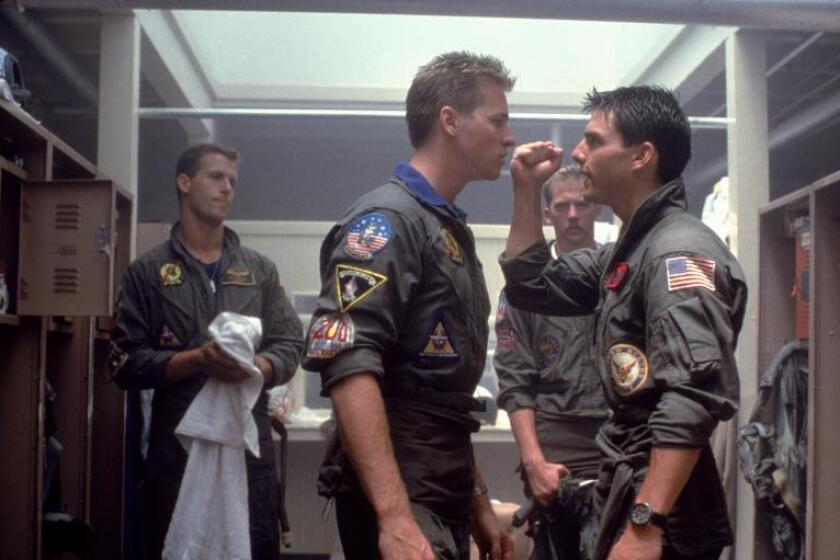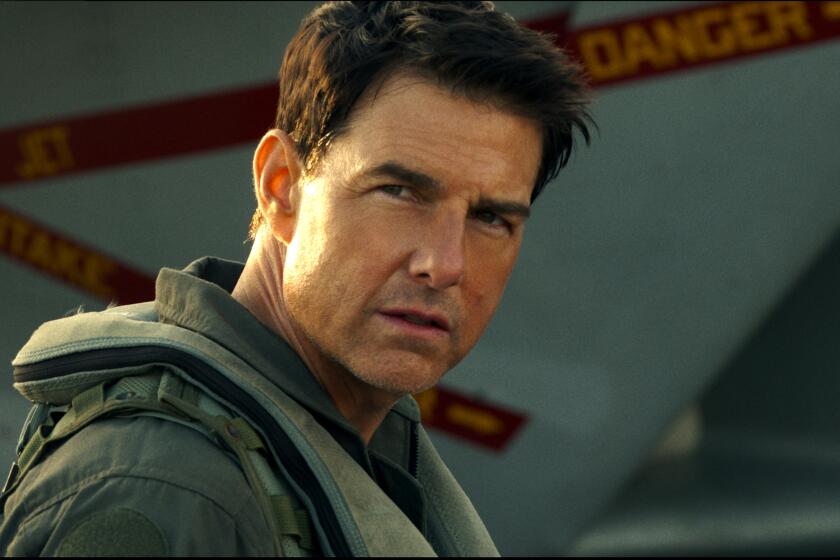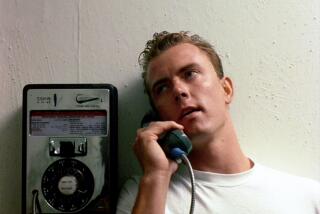Who is the enemy in ‘Top Gun: Maverick’? Let’s investigate
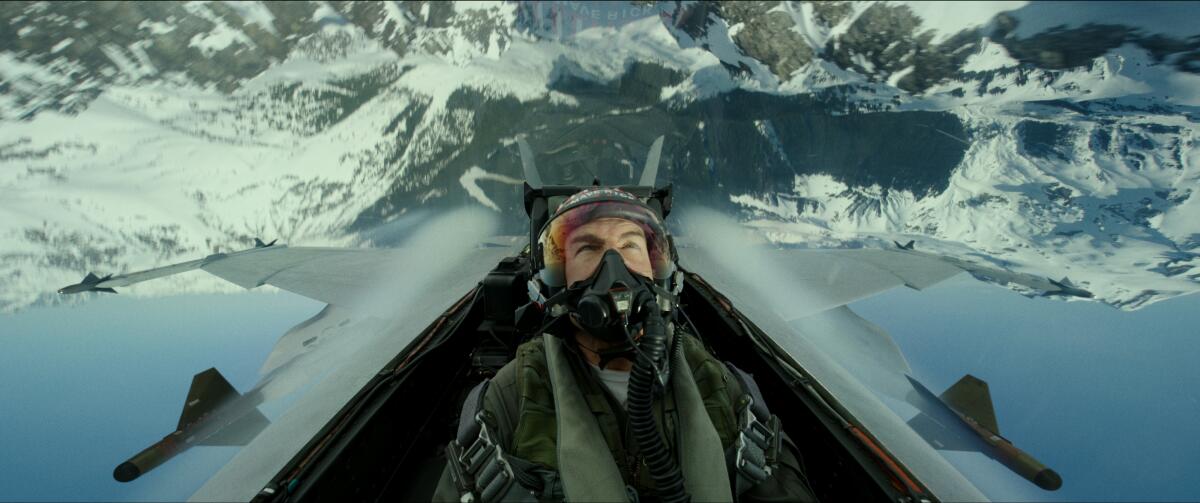
- Share via
Warning: The following article contains mild spoilers from “Top Gun: Maverick.”
The mission for Tom Cruise’s Pete “Maverick” Mitchell and his ace team of young Navy fighter pilots is clear: to take out a nuclear enrichment facility. The risks are even clearer: perilous terrain, anti-aircraft systems, adversaries flying cutting-edge stealth jets.
There’s just one thing that is not clear in “Top Gun: Maverick” — and it happens to be a pretty important thing: Who exactly is the enemy? In “Top Gun: Maverick,” that question is left intentionally fuzzy, with the film offering vague and contradictory hints about the antagonist that don’t quite add up.
The fact is, ambiguity about the enemy — like shirtless beach sports, high-speed motorcycle rides and aviator sunglasses — has been baked into the “Top Gun” franchise from the beginning.
Some of the best acting work in the sequel happens because of returning star Val Kilmer. And not just Kilmer’s acting work.
In 1986, when the original “Top Gun” was released, America was still in the grips of the Cold War with the Soviet Union and Russians were frequently the go-to bad guys for Hollywood, whether it was the towering Ivan Drago in “Rocky IV” or the army that invades a small Colorado town in “Red Dawn.” But while “Top Gun” served as a powerful recruitment tool for the American military — naval recruitment rates jumped 500% in the year after its release — the film never explicitly named the adversary.
The Soviet-made MiG-28s that Maverick and Goose take on in that film’s climactic mission were fictional (all postwar MiG aircraft have been odd-numbered). The enemy aircraft in the movie were actually American-made Northrop F-5s, painted with tail markings — a red star inside a yellow circle — that borrowed elements from Soviet, Chinese and North Korean military planes without precisely matching any of them. By setting the climactic encounter in the Indian Ocean, the film further obscured who exactly the antagonists were.
In “Top Gun: Maverick,” the enemy is depicted as a rogue nation that possesses a fleet of fifth-generation fighter planes and is attempting to enrich uranium to develop nuclear weapons at a fortified site hidden in forbidding mountainous terrain.
But otherwise the film offers no real clues as to who the adversary might be. Its pilots and military personnel on the ground are never heard speaking. Its aircraft have no discernible insignia that would point to a particular nation. Speaking of the mission to the young fighter pilots he’s charged with training, Cruise’s Maverick says, “Time is your greatest adversary,” which doesn’t help clarify matters any.
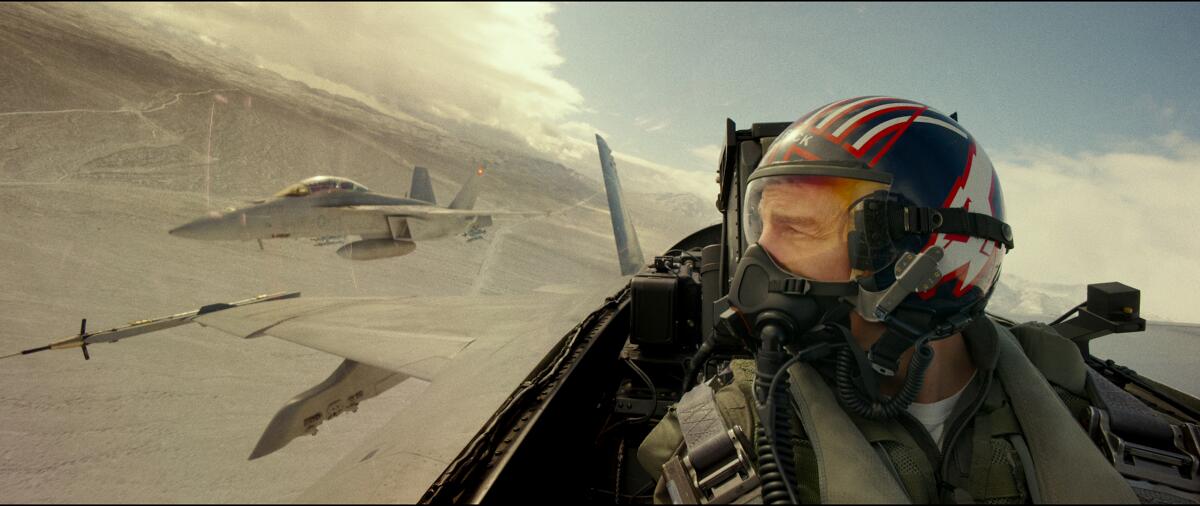
The most obvious contenders at first glance would seem to be Russia or China. The Russian and Chinese military each operate fifth-generation aircraft — indeed, the enemy aircraft in the film appear to be based on Russian Su-57 stealth fighter jets — and the snowy, jagged topography where the uranium-enrichment facility is located could conceivably be found in one of those countries.
But both Russia and China are already established nuclear powers and direct military engagement with either one would plunge the U.S. immediately into World War III, so the notion that the U.S. Navy would undertake a risky mission to take out such a facility in either country is implausible in the extreme. And while Russia is considered a rogue state — a loose term used by international theorists to refer to countries that threaten global peace and order — by the U.S. government, China is not.
What about North Korea or Iran? Both countries are considered rogue states by the U.S. Both have snow-capped mountain ranges and nuclear ambitions that America and its allies are determined to try to contain. But neither country has operational fifth-generation fighter jets. (Iran announced the development of its own stealth IAIO Qaher-313 in 2013, but independent military experts have expressed doubts about the viability of the aircraft.)
Though production was completed in 2019, there are good reasons that Paramount Pictures and the makers of “Top Gun: Maverick” would want to steer clear of explicitly identifying the film’s enemy as the project hits theaters after multiple pandemic-related release delays. With the world already roiled by tensions over Russia’s invasion of Ukraine and China’s saber-rattling over Taiwan, the last thing the filmmakers want is to be seen as throwing more fuel on any geopolitical fires.
Tom Cruise’s ‘Top Gun’ sequel remembers the original with plenty of nostalgic callbacks. Here are 17 you might have missed.
There are also significant box office considerations. China is on track to be the world’s biggest cinema market in 2022 for the third year in a row and Cruise, who has spent his entire career carefully cultivating a global audience, has frequently traveled to the country to promote films including “Jack Reacher,” “Oblivion” and the “Mission: Impossible” movies. (According to the Wall Street Journal, Chinese tech firm Tencent Holdings Ltd. initially planned to co-finance “Top Gun: Maverick” but pulled out over concerns that Communist Party officials would disapprove of its involvement with a film celebrating the American military.)
While it is unclear at this point whether “Top Gun: Maverick” will secure a China release, the makers of the film would be foolish to preemptively shut the door to such a massive potential audience. (No release is planned in Russia at this time.)
The film’s screenwriters were not available to be interviewed for this story. But speaking to The Times recently, singer Kenny Loggins — whose hit song “Danger Zone” from the original film’s soundtrack is brought back for an encore in the new film — said he, for one, is glad that “Top Gun: Maverick” doesn’t identify the enemy.
“I think it was a wise decision,” Loggins said. “The planes have no markings. The uniforms have no markings. They’re just the bad guys who are building up nuclear stockpiles, and we have to stop them. It’s not the American military that’s overthrowing the government somewhere.”
If there’s anyone who knows about staying out of the danger zone, it’s Kenny Loggins.
Times staff writer Mikael Wood contributed to this report.
The actor teams up with director Joseph Kosinski and reunites with Val Kilmer in this grander, weightier sequel to the 1986 blockbuster.
More to Read
Only good movies
Get the Indie Focus newsletter, Mark Olsen's weekly guide to the world of cinema.
You may occasionally receive promotional content from the Los Angeles Times.
